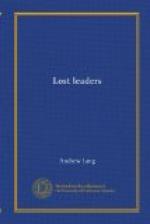Any degree of skill in these varied feats makes golf a delightful game, if the opponents are well matched. Nor are the charms of scenery wanting at St. Andrews, the headquarters of the sport. There is no more picturesque town in Scotland than the little university city. From the plain of the estuary of the river Eden, across the long leagues of marsh land and the stretches of golden sand and brown, the towers of St. Andrews—for it is a town of many towers—are seen breaking the sky-line. Built on a windy headland, running out to the grey northern sea, it reaches the water with an ancient pier of rugged stone. Immediately above is the site of a chapel of immemorial age, and above that again are the ruins of the cathedral—gaunt spires with broken tracery, standing where once the burnished roof of copper flashed far across the deep. The high street winds from the cathedral precinct past an old house of Queen Mary Stuart, past ruined chapels of St. Leonard’s, and the university chapel with its lovely spire, down to the shores of the bay; and along the bay run the famous “links,” where the royal and ancient game has its cradle and home. Other links, as Prestwick, or North Berwick, may vie with those of St. Andrews in extent, or in the smoothness of the putting greens, or in the number and hardness of the “hazards,” or difficult places; but none offer so wide and varied an extent of scenery, from the melancholy stretch of the parallel sands to the hills in the west, the golden glitter of the beach, beneath the faint aerial blue of the still more distant hills across the firth, while behind is the city set on its cliffs, and proud with its crown of spires. The reflected sunset lingers on the walls and crags and towers, that shine imaged in the wet sands, the after-glow hangs over the eastern sky, and these have their charm; but their charm yields to that of golf. It is a sign that a man has lost heart and hope when he dilates on the beauty of the scenery, and abstracts his attention from what alone would interest him were he winning—the “lie” of his ball. Who can stop to think of the beauties of nature, when he and his antagonist are equal, and there are only two more holes left to play in the match for the medal? It is a serious moment; not one of the little crowd of observers, the gallery that accompany the players, dares to speak, or even cough. The caddie who sneezes is lost, for he will be accused of distracting his master’s attention. The ladies begin to appear in the background, ready to greet the players, and to tell the truth, are not very welcome to the nervous golfer. Everything turns on half an inch of leather in a “drive,” or a stiff blade of grass in a putt, and the interest is wound up to a really breathless pitch. Happy he is who does not in his excitement “top” his ball into the neighbouring brook, or “heel” it and send it devious down to the depths of ocean. Happy is he who can “hole out the last hole in four” beneath the eyes of the ladies. Striding victorious into the hospitable club, where beer awaits him, he need not envy the pheasant-slayer who has slain his hundreds.




